E.G. Wolverson's Blog, page 20
May 9, 2013
Beyond History's End | 50th Anniversary Doctor Who Review 3 of 12 | The Scorchies by James Goss

With a recently-released Katy Manning Companion Chronicle still sizzling on the shelf, I didn’t have to think too hard about which previously-uncharted third Doctor adventure I’d be tackling for Beyond History’s End – particularly as it sported one of the most outlandish and irresistible covers that I recall ever seeing on a Big Finish title. A pink velvety cat, a foul professor, a chilling baby doll, a purple-bearded puppet with a ray gun and three blind drunk mice encircle an evidently-irked Jo Grant. It’s not your customary Who recipe, I’ll grant you, but lost amongst the CSO showiness of the series’ early days in colour, James Goss’s semi-satire on light entertainment feels oddly at home.
 Despite having produced more hours of Doctor Whothan even the BBC, The Scorchies is positive proof that Big Finish Productions are every bit as innovative and as intrepid as ever they were. The two episodes that comprise this story may each be bookended by a familiar Delia Derbyshire ditty, but what lies in between is another show altogether – The Scorchies Show – on which this week’s guest just happens to be the Doctor’s captured assistant.
Despite having produced more hours of Doctor Whothan even the BBC, The Scorchies is positive proof that Big Finish Productions are every bit as innovative and as intrepid as ever they were. The two episodes that comprise this story may each be bookended by a familiar Delia Derbyshire ditty, but what lies in between is another show altogether – The Scorchies Show – on which this week’s guest just happens to be the Doctor’s captured assistant. Listening to the production, it’s immediately apparent how much fun its writer had using just about every trashy telly trope employed in the 1970s to tell his story, and even more so how the cast and crew revelled in making his wacky vision an acoustic reality. From Jo being forced to “make a thing” out of bog roll to the series’ first-ever musical cliffhanger, The Scorchies delights in eschewing the structure and staples of not only Doctor Who, but drama full stop.
As the first episode opens, the listener almost feels as if they’re joining a Season 8 serial’s third or fourth episode, as the events that have led Jo to her prime time terror have all passed, and all that remains is for the Doctor and UNIT to mount their rescue and put paid to the bizarre alien threat. Events seem to take place in real time, as if they’re being broadcast live as part of The Scorchies Show – even the deliberately-artificial flashbacks that bring the listener up to speed and, later, explore the “sad story” of the telly-mad species that would eventually become the Scorchies. There isn’t a moment in this production that feels like an audio book; there isn’t even a moment that feels like two-hand audio drama. From its first moment to its last, The Scorchies is the soundtrack to a Saturday night variety show, somehow all of its many colourful characters coming out of the mouths of versatile voice artists Melvyn Hayes and Katy Manning (and equally-versatile Blacklight Studio songsters Richard Fox and Lauren Yason).
If this story has a flaw, it’s that it’s too effective a send-up of the shows that it spoofs. It’s so incessantly shrill and so offensively jaunty that I found my brow permanently furrowed all the way through it, as if in actual pain. I didn’t that Big Finish would ever outdo the crippling Cuddlesome, but it seems we have a new champ.
The Scorchies is available to download from Big Finish for just £7.99. The CD version (which also comes with a free download) is just a pound extra.
 The Grange is haunted, so they say. This stately home in the depths of Devon has been the site of many an apparition. And now people are turning up dead. The ghosts are wild in the forest. But the Doctor doesn’t believe in ghosts. The TARDIS follows a twist in the vortex to the village of Staffham in 1977 and discovers something is very wrong with time. But spectral highwaymen and cavaliers are the least of the Doctor’s worries.
The Grange is haunted, so they say. This stately home in the depths of Devon has been the site of many an apparition. And now people are turning up dead. The ghosts are wild in the forest. But the Doctor doesn’t believe in ghosts. The TARDIS follows a twist in the vortex to the village of Staffham in 1977 and discovers something is very wrong with time. But spectral highwaymen and cavaliers are the least of the Doctor’s worries.For the Grange is owned by the sinister Jalnik, and Jalnik has a scheme two thousand years in the making. Only the Doctor and Leela stand between him and the destruction of history itself. It’s the biggest adventure of their lives – but do they have the time?
Read retro Doctor Who reviews @

Published on May 09, 2013 03:27
May 2, 2013
DVD Reviews | Doctor Who - The Aztecs (Special Edition) and The Ark in Space (Special Edition)
Published on May 02, 2013 14:20
April 20, 2013
Beyond History’s End | 50th Anniversary Doctor Who Review 2 of 12 | The Wheel of Ice by Stephen Baxter

With sales dwindling to near-breadline levels, in December 2005 BBC Books quietly decided to give classic Doctor Who novels a “rest” – words that, quite rightly, sent a chill down the spine of every savvy Who reader. Fortunately, through their countless series of audio dramas and, later, audio books, the inexhaustible Big Finish Productions were able to keep the classic series’ flame burning hot during this literary hiatus, but if you were hard of hearing or just a lover of good old-fashioned words and paper, your access to new old Who fiction had been blocked. In August last year though, BBC Books began its ‘Past Doctor’ reboot, and I’m very happy to report that, despite its break being less than half as long as that the television series had to endure, the range has returned every bit as renewed, and I dare say every bit as vendible, as the show itself did in 2005.
 A hardback tome clad in the handsome dust jacket of a certain bestseller, The Wheel of Ice is a completely different animal to Andrew Cartmel’s half-hearted paperback, Atom Bomb Blues – the last Doctor Who book to follow the exploits of a pre-2005 Doctor. In the mould of Michael Moorcock’s convention-busting eleventh Doctor novel, The Coming of the Terraphiles, author Stephen Baxter’s name takes up as much room on the pale and icy cover as the ashen Doctor Whologo does – and rightly so, for it is every bit as at home amongst its illustrious author’s esteemed canon of works as it is between The Seeds of Death and The War Games. But unlike Moorcock, who very deliberately had his own private universe literally open up and swallow the TARDIS, Baxter firmly grounds his tale in the monochrome world of the late Patrick Troughton era. From its almost-farcically metropolitan cast of characters all the way up to its redolent title, The Wheel of Ice is as Whoas Who can ever be; at times, it feels like Baxter’s a lone Li H’sen Chang or Black Orchid reference away from descending into the realms of pure fanwank. But after seven years in the wilderness, this is exactly what I was looking for from this title – and I’d wager that I’m not the only one.
A hardback tome clad in the handsome dust jacket of a certain bestseller, The Wheel of Ice is a completely different animal to Andrew Cartmel’s half-hearted paperback, Atom Bomb Blues – the last Doctor Who book to follow the exploits of a pre-2005 Doctor. In the mould of Michael Moorcock’s convention-busting eleventh Doctor novel, The Coming of the Terraphiles, author Stephen Baxter’s name takes up as much room on the pale and icy cover as the ashen Doctor Whologo does – and rightly so, for it is every bit as at home amongst its illustrious author’s esteemed canon of works as it is between The Seeds of Death and The War Games. But unlike Moorcock, who very deliberately had his own private universe literally open up and swallow the TARDIS, Baxter firmly grounds his tale in the monochrome world of the late Patrick Troughton era. From its almost-farcically metropolitan cast of characters all the way up to its redolent title, The Wheel of Ice is as Whoas Who can ever be; at times, it feels like Baxter’s a lone Li H’sen Chang or Black Orchid reference away from descending into the realms of pure fanwank. But after seven years in the wilderness, this is exactly what I was looking for from this title – and I’d wager that I’m not the only one.
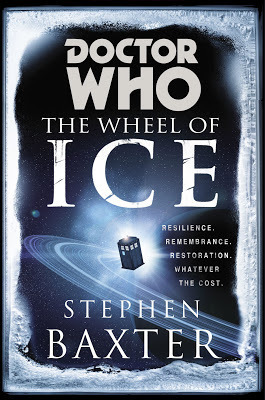 What impresses the most about this book though is that Baxter doesn’t let his evident ardour for the series limit his scope. Whilst it’s evocative of a second Doctor serial almost to a fault, the story feels contemporary and complex; eminent, even. It may be peppered with moments of horror that evoke Auton-like terror through prose that Stephen King would envy, but at heart it’s a personal and political soap opera that calls to mind J K Rowling’s Casual Vacancy, which was published just six weeks after it. Both use a young heroine as a window into a world of human folly; a world of “hard work and regulations” where, behind closed doors, the overburdened youths are every bit as powerful as their parents, and perhaps even more capable. This isn’t a tale carried by the sleeping alien Arkive and its flesh-metamorphosing Blue Doll creations – it’s carried by a daughter whose transmat-inventing father’s disgrace has driven her to greed and aggression; an affable robot “fae Glasgae” who grew up dreaming that he’d play for Celtic, only to hit puberty and be told that he hasn’t got any feet; a mayor and a mother whose uneasy relationship with her son captures absolutelythe war that’s raging within the colony in microcosm. Such carefully-considered and delectably-delivered character flourishes are the perfect complement to the author’s Power of the Daleks-league world-building, the two combining to refashion the archetypal Troughton “base under siege” story into perhaps its most enthralling form to date.
What impresses the most about this book though is that Baxter doesn’t let his evident ardour for the series limit his scope. Whilst it’s evocative of a second Doctor serial almost to a fault, the story feels contemporary and complex; eminent, even. It may be peppered with moments of horror that evoke Auton-like terror through prose that Stephen King would envy, but at heart it’s a personal and political soap opera that calls to mind J K Rowling’s Casual Vacancy, which was published just six weeks after it. Both use a young heroine as a window into a world of human folly; a world of “hard work and regulations” where, behind closed doors, the overburdened youths are every bit as powerful as their parents, and perhaps even more capable. This isn’t a tale carried by the sleeping alien Arkive and its flesh-metamorphosing Blue Doll creations – it’s carried by a daughter whose transmat-inventing father’s disgrace has driven her to greed and aggression; an affable robot “fae Glasgae” who grew up dreaming that he’d play for Celtic, only to hit puberty and be told that he hasn’t got any feet; a mayor and a mother whose uneasy relationship with her son captures absolutelythe war that’s raging within the colony in microcosm. Such carefully-considered and delectably-delivered character flourishes are the perfect complement to the author’s Power of the Daleks-league world-building, the two combining to refashion the archetypal Troughton “base under siege” story into perhaps its most enthralling form to date.I must also applaud Baxter’s magnificent structure, which sees a 368-page hardback divided into dozens of bite-size chapters and interludes, imbuing it with a sense of pace that a television four-parter would struggle to match, let alone a near-ten-hour epic (roughly the length of the novel when read by David Troughton). The (mostly) flashback interludes are a particular treat as each is presented almost as a stand-alone piece of short fiction – a couple of them completely so. MMAC’s life story is as compelling as any one-off that you’ll find in a science fiction anthology, and the story of Mayor Laws’ family’s “allohistorical lure” is dripping with such vivid detail that when its narrative (which begins in the 19th century) overtook the present day and fact became fiction, I scarcely noticed. Baxter doesn’t drop prosaic bombs like “She got into her flying car…”, for instance – he refers to that car by its manufacturer’s name, as we might a BMW or a Volvo. It’s only once it takes off that the penny drops and the reader is left trying to work out when then segued into the day after tomorrow.
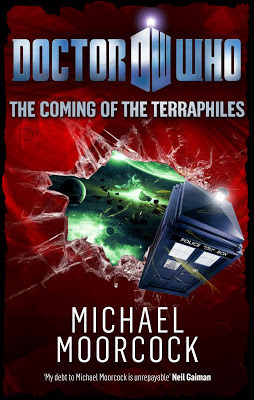 Even where The Wheel of Ice couldn’t expect to compete with a second Doctor television story, it acquits itself commensurately. Baxter’s dialogue captures Troughton’s rambling rhythm flawlessly, and his prose paints the perfect picture of an outward ‘cosmic hobo’ with a steely darkness sleeping in his soul. His Jamie is, in many respects, even more remarkable – Baxter is one of the few Doctor Who scribes who’s had the gall to dispense with any semblance of the English language and simply set out the Highlander’s dialect exactly as it sounds, in a flurry of missing consonant-apostrophes and extraneous Scots vowels (as opposed to simply throwing in the occasional “Och aye”, as is the temptation for many writers). It’s like reading Irvine Welsh without the profanity – unless, of course, you count “cudgie”. Even hard-to-write-for brainbox Zoe is taken somewhere new as Baxter mischievously inverts convention, sending Jamie out to build the Doctor’s neutrino device (which he does, believe it or not!), while Zoe has to put her genius-level IQ to work babysitting for the mayor’s daughter and playing makeshift peacemaker.
Even where The Wheel of Ice couldn’t expect to compete with a second Doctor television story, it acquits itself commensurately. Baxter’s dialogue captures Troughton’s rambling rhythm flawlessly, and his prose paints the perfect picture of an outward ‘cosmic hobo’ with a steely darkness sleeping in his soul. His Jamie is, in many respects, even more remarkable – Baxter is one of the few Doctor Who scribes who’s had the gall to dispense with any semblance of the English language and simply set out the Highlander’s dialect exactly as it sounds, in a flurry of missing consonant-apostrophes and extraneous Scots vowels (as opposed to simply throwing in the occasional “Och aye”, as is the temptation for many writers). It’s like reading Irvine Welsh without the profanity – unless, of course, you count “cudgie”. Even hard-to-write-for brainbox Zoe is taken somewhere new as Baxter mischievously inverts convention, sending Jamie out to build the Doctor’s neutrino device (which he does, believe it or not!), while Zoe has to put her genius-level IQ to work babysitting for the mayor’s daughter and playing makeshift peacemaker.The story concludes exactly as it should, with a cliffhanger befitting the era that inspired it, and that I hope will, one day, lead into another hardbound adventure for this TARDIS team with Stephen Baxter’s emblazoned on its dust jacket. After seven years without an original classic Doctor Who novel, The Wheel of Ice seamlessly fuses old with new and niche with mainstream to create a ‘Past Doctor’ adventure that has set a new standard for Who fiction, and will hopefully serve as a launching pad for a whole new range of books with a welcome focus on quality, not quantity.
The Wheel of Ice is currently available in hardback (best price online today: £10.86 at The Book Depository) and digital formats (£9.49 from Amazon’s Kindle Store or £9.99 from iTunes), and is due to be released in paperback on 1st August 2013.
 The Doctor, his companion Jo Grant and the Brigadier face their strangest case yet – a Saturday night TV show that has been invaded by aliens that look like puppets!
The Doctor, his companion Jo Grant and the Brigadier face their strangest case yet – a Saturday night TV show that has been invaded by aliens that look like puppets! The Scorchies want to take over the world. They want to kill the Doctor. And they want to perform some outstanding showtunes. Though not necessarily in that order…
With Jo caught inside The Scorchies Show, can she save the day before the planet Earth falls victim to the dark side of light entertainment?
Read retro Doctor Who reviews @

Published on April 20, 2013 14:11
April 11, 2013
The Guardian | Thursday 11th April 2013
My Uncle Mick goes boldly where no Wolverson has ever gone before, making The Guardian’s letters and emails page with his (more dignified than “Ding Dong!”) Maggie Thatcher indictment.
Well said R Mick.

Well said R Mick.

Published on April 11, 2013 13:40
April 9, 2013
Beyond History’s End | 50th Anniversary Doctor Who Review 1 of 12 | The First Wave by Simon Guerrier

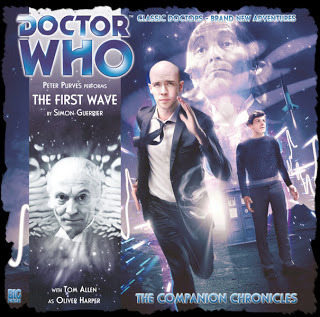 Whilst Big Finish’s Companion Chronicles range was originally conceived with a view to telling traditional stories from the perspective of the first four Doctors’ companions, over its six seasons it has evolved to encompass adventures that are every bit as reminiscent of the current television series as they are the old black-and-white Hartnells that spawned it, which from my standpoint makes them compulsively appealing. And just like The Perpetual Bond and The Cold Equations before it, The First Wave is a case in point.
Whilst Big Finish’s Companion Chronicles range was originally conceived with a view to telling traditional stories from the perspective of the first four Doctors’ companions, over its six seasons it has evolved to encompass adventures that are every bit as reminiscent of the current television series as they are the old black-and-white Hartnells that spawned it, which from my standpoint makes them compulsively appealing. And just like The Perpetual Bond and The Cold Equations before it, The First Wave is a case in point.Now ‘linear’ isn’t a word that you’ll see often thrown about when discussing the plot of a Doctor Who story, but if you study the series’ earliest episodes, they customarily followed a linear narrative; hell, they were even shot that way in the beginning. In direct defiance of this, Simon Guerrier’s script opens with a cliffhanging pre-title sequence that Steven Moffat would be proud of, sucking the listener into what feels very much like a typical second episode – at least, for a while. Like a Whovian Tarantino shooting in a darkened room, Guerrier dramatically segues between two-hand audio drama and descriptive rewinds. Those who favour listening to their Big Finish productions whilst serenely lying down can forget about it; The First Wave’s ceaseless suspense will have you fidgeting at the very least.

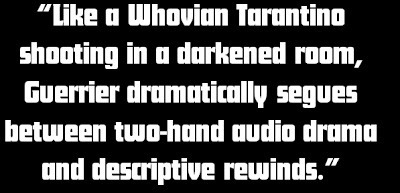 The preceding adventure for this TARDIS crew did a lovely job of setting up the predestination paradox that Guerrier’s plot centres around, and this one does an even better job of bringing it to the boil without rehearsing too much of The Space Museum and other stories of the same ilk. Furthermore, as with his last Companion Chronicles trilogy, Guerrier resurrects an antagonist from the television series to lend his final instalment a little extra lustre – this time around, it’s the Vardans of The Invasion of Timefame (or, perhaps more aptly, infamy). A loose prequel to the 1970s Tom Baker serial, The First Wave presents the Vardans perhaps as they should have been seen on television – as terrifying, omnipresent creatures that can travel along any form of wave – even a brainwave – and thus from whom there can be no escape. Divorced from the appallingly banal visuals of The Invasion of Time and embellished by the mid-GCSE writer’s foundation level science, the Vardans have at last found their perfect home amongst this production’s soundwaves.
The preceding adventure for this TARDIS crew did a lovely job of setting up the predestination paradox that Guerrier’s plot centres around, and this one does an even better job of bringing it to the boil without rehearsing too much of The Space Museum and other stories of the same ilk. Furthermore, as with his last Companion Chronicles trilogy, Guerrier resurrects an antagonist from the television series to lend his final instalment a little extra lustre – this time around, it’s the Vardans of The Invasion of Timefame (or, perhaps more aptly, infamy). A loose prequel to the 1970s Tom Baker serial, The First Wave presents the Vardans perhaps as they should have been seen on television – as terrifying, omnipresent creatures that can travel along any form of wave – even a brainwave – and thus from whom there can be no escape. Divorced from the appallingly banal visuals of The Invasion of Time and embellished by the mid-GCSE writer’s foundation level science, the Vardans have at last found their perfect home amongst this production’s soundwaves.As with its two predecessors, I found the most enthralling segments of this story to be those that simply see Peter Purves play Steven and Tom Allen play Oliver. To say that this is Oliver’s final turn, Guerrier’s script is exceedingly kind to his space pilot cohort, building upon the six-dimensional groundwork laid in The Cold Equations by having him step up the plate in the Doctor’s absence, drawing upon his wartime experiences to help guide his judgement and steel his stomach. The former Blue Peter man and I’m Alan Partridge joke-butt gives a duly stirring performance as his character deals with his mentor’s apparent demise as well as his and his remaining friend’s apparently-inexorable fate (and indeed the pending subjugation of all time and space by the Vardans), and once more he makes for a credible first Doctor to boot. In my reviews of previous Purves-led Companion Chronicles for The History of theDoctor , I wore out my lexicon trying to describe just how evocative his portrayal of Hartnell’s Doctor is, so this time around I’ll just quote the man himself: “I do a mean Doctor,” says he. And so he does.
 Oliver is again engrossing too, this story (and particularly its dénouement) ably demonstrating how much the character has matured since we first met him fleeing arrest in his native 1960s. I won’t spoil his fate for those yet to hear it, save for to say that I was very impressed with how both Guerrier’s writing and Allen’s portrayal brought out the emotional logic in Oliver’s psychology. For those that thought The Cold Equations had blown the lid on why Oliver was so keen to flee Earth with the Doctor and Steven at the end of The Perpetual Bond, you might be aware of the facts, but the real heartbreak lies in Oliver’s interpretation of them; in the stain of criminality that his vanity can’t abide, no matter how unjust the laws that would condemn him. It’s his desperate evasion of this stigma that drives him to join the Doctor and Steven aboard the TARDIS, and eventually leads him to the (beautifully-named) planetoid Grace Alone, where his already-written fate awaits him.
Oliver is again engrossing too, this story (and particularly its dénouement) ably demonstrating how much the character has matured since we first met him fleeing arrest in his native 1960s. I won’t spoil his fate for those yet to hear it, save for to say that I was very impressed with how both Guerrier’s writing and Allen’s portrayal brought out the emotional logic in Oliver’s psychology. For those that thought The Cold Equations had blown the lid on why Oliver was so keen to flee Earth with the Doctor and Steven at the end of The Perpetual Bond, you might be aware of the facts, but the real heartbreak lies in Oliver’s interpretation of them; in the stain of criminality that his vanity can’t abide, no matter how unjust the laws that would condemn him. It’s his desperate evasion of this stigma that drives him to join the Doctor and Steven aboard the TARDIS, and eventually leads him to the (beautifully-named) planetoid Grace Alone, where his already-written fate awaits him.Like a lot of listeners, I doubted that Guerrier would ever surpass his Sara Kingdom stories, but with the trilogy that The First Wavecrowns, I think that he just might have. Bringing a character back from the dead as a house suddenly doesn’t seem quite so inventive when it’s measured against teaming up the ascetic first Doctor with a bowler hat-doffing gay banker who’s more afraid of a criminal record than he is alien monsters and outer space. The First Wave is available to download from Big Finish for just £7.99. The CD version (which also comes with a free download) is just a pound extra.
 The Wheel. A ring of ice and steel turning around a moon of Saturn, and home to a mining colony supplying a resource-hungry Earth. It's a bad place to grow up.
The Wheel. A ring of ice and steel turning around a moon of Saturn, and home to a mining colony supplying a resource-hungry Earth. It's a bad place to grow up.The colony has been plagued by problems. Maybe it’s just gremlins, just bad luck. But the equipment failures and thefts of resources have been increasing, and there have been stories among the children of mysterious creatures glimpsed aboard the Wheel.
Many of the younger workers refuse to go down the warren-like mines anymore. And then sixteen-year-old Phee Laws, surfing Saturn’s rings, saves an enigmatic blue box from destruction.
Aboard the Wheel, the Doctor, Jamie and Zoe find a critical situation - and they are suspected by some as the source of the sabotage. They soon find themselves caught in a mystery that goes right back to the creation of the solar system. A mystery that could kill them all.

Published on April 09, 2013 03:31
April 4, 2013
Book Review | Star Trek: Typhon Pact - Seize the Fire by Michael A Martin
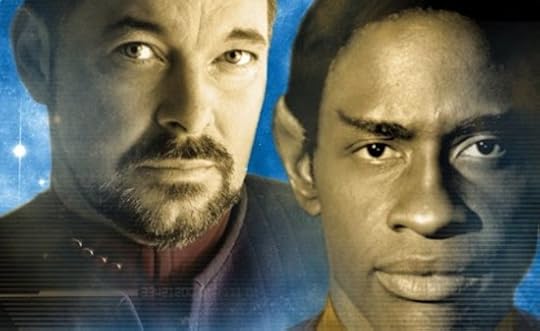 The Typhon Pact miniseries’ second instalment is a Titan novel in all but name. Cut of the same cloth as the preceding six stand-alone Titan books and penned by one of its creators, Michael A Martin, this volume picks up right where Synthesis left off. The fact that its antagonists, the Gorn, are members of the Typhon Pact is the book’s only tie to what is starting to look very much like the loosest of story arcs.
The Typhon Pact miniseries’ second instalment is a Titan novel in all but name. Cut of the same cloth as the preceding six stand-alone Titan books and penned by one of its creators, Michael A Martin, this volume picks up right where Synthesis left off. The fact that its antagonists, the Gorn, are members of the Typhon Pact is the book’s only tie to what is starting to look very much like the loosest of story arcs.Particularly when measured against the much more dynamic Zero Sum Game, Seize the Fire is a bloated, dawdling affair. Whereas David Mack’s Breen thriller borrowed elements from the James Bond series and repackaged them for the Star Trek universe, Martin’s Gorn gambit simply borrows elements from a few Star Trek movies (even the Titan crew have to point out that the ecosculptor co-opted by the Gorn is exactly like the Genesis Device, and that the fate of the Gorn warrior caste’s crècheworld is the same as that which befell the Klingon moon Praxis) and raises the stakes a little, as the Gorn plan to terraform an already-inhabited (but pre-first contact, “hands-off”) planet to use as a new hatchery for their moribund warriors. The plot is therefore carried as much by extensive deliberations on the interpretation of Starfleet’s Prime Directive as it is action or incident, which isn’t automatically a problem; the problem comes when the book is stretched to almost 500 pages. Even a neat plot twist around the half-way point wasn’t quite enough to keep me engaged.
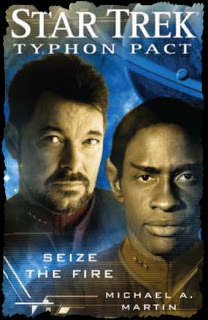
What Martin does do very effectively though is provide an intriguing view of the Gorn Hegemony from the ground up; or, rather, the outside-in. Seize the Fire introduces us to the multi-caste society through its pirates and extremists lurking on the edge of their territory; even through one of its number who has been thrown overboard for showing conscience. Through this character, S’syrixx, Martin is able to convey just how similar to us the Gorn actually are, without losing sight of the innate, mutual fear and revulsion that both species struggle to overcome. Martin’s description of the terror and disgust inspired by the mammal Rry’kurr’s “fur” is almost worth the purchase price in of itself.
Overall though, I think that most will find Seize the Fire too much work for too little reward. Unless you’re determined to follow every chapter of the Federrazsh’n vs Typhon Pact saga, no matter how remote or recycled, this is definitely one to skip over.
Published on April 04, 2013 00:39
April 3, 2013
Andrew Exley (1981-2013)

We liked to drink with Andy, ’cos Andy was our mate
We liked to drink with Andy, ’cos Andy was so great Now the Old Boys will always be one short
And our drinking song doesn’t rhyme anymore




Published on April 03, 2013 00:30
April 1, 2013
Blu-ray Review | The Attitude Era
 For those who never experienced it, it’s hard to convey the significance of what’s come to be termed the “Attitude Era” of professional wrestling. In the late ’80s and early ’90s, pro wrestling was colourful, cartoon entertainment aimed squarely at kids and the relatives that they’d drag along to the arenas. The then-World Wrestling Federation’s family-friendly show would see virtuous superheroes the likes of Hulk Hogan and Bret “Hitman” Hart battling overblown villains either torn from the pages of a comic book or hastily contrived for a nation at war in the Gulf to rally against. Like a lot of lads born around the time that I was, I would sit rapt in front of the television for hours as these simple morality pantomimes played out before me, only for them to quickly lose their appeal as puberty hit. But then one night in 1999, something happened...
For those who never experienced it, it’s hard to convey the significance of what’s come to be termed the “Attitude Era” of professional wrestling. In the late ’80s and early ’90s, pro wrestling was colourful, cartoon entertainment aimed squarely at kids and the relatives that they’d drag along to the arenas. The then-World Wrestling Federation’s family-friendly show would see virtuous superheroes the likes of Hulk Hogan and Bret “Hitman” Hart battling overblown villains either torn from the pages of a comic book or hastily contrived for a nation at war in the Gulf to rally against. Like a lot of lads born around the time that I was, I would sit rapt in front of the television for hours as these simple morality pantomimes played out before me, only for them to quickly lose their appeal as puberty hit. But then one night in 1999, something happened...Arriving home in the early hours of the morning after a night of drunken debauchery, a mate of mine and I were channel-hopping when we came across a spectacle on Sky Sports 1 that kept us up long past 4am. The black-clad Big Boss Man, whom we had known only as a blue and yellow-sporting corrections office caricature, had been hanged from a colossal steel structure that surrounded a wrestling ring in what looked very much like an impromptu execution. Gothic figures wearing baggy white shirts, fangs and sunglasses ascended to the rafters, clearly the perpetrators of the crime, and below stood the portentous figure of the Undertaker – once a haunting, quasi-supernatural mortician who said nothing but “Rest in peace”; by then a pointy-bearded, heavily-tattooed cult leader, who habitually rolled his eyes into the back of his head and talked in tongues as he presided over the atrocities wrought by his ‘Ministry of Darkness’. Times had certainly changed. This ‘Hell in a Cell Match’ quickly gave way to a contest for the WWF Championship between a bald-headed, beer-swilling redneck whom we quickly realised was the modern equivalent of the Hulkster – but somehow his very antithesis too. Vitamins had become cans of lager; saying one’s prayers had become flipping the bird. The WWF had gone and found itself an attitude, just as the children that had grown up glued to it in the ’80s had started to develop their own.
 From there, RAW become a weekly fixture for us on a Friday night / Saturday morning, pushing every late-teen button. With the company locked in a bitter ratings war with its (in the USA) Monday night rival, the now-renegade Hogan-led WCW, every segment of the show was designed to be as appealing to the 18-34 male demographic as possible, abounding with everything from bloodbaths to breasts. Whereas in my childhood days, a wrestler’s gimmick would be something as clear-cut as being rich and ruthless (the Million Dollar Man); arrogant and affected (Ric Flair); perfect and proud of it (Curt “Mr Perfect” Hennig); or even just running to the ring really fast and spouting utter bollocks with terrifying conviction (the Ultimate Warrior), in this Attitude Era, a perfectly-acceptable gimmick would be, say, being an adult film star (Val Venis); a pimp (the Godfather); an almost-preposterously lewd degenerate (D-Generation X); or even having a predilection for arses (Billy Gunn, also known as ‘Mr Ass’, later of ‘Billy and Chuck’ fame). Back in the day, a special match would be something like a Casket Match, which could be won by shoving the other guy in a coffin; in this era, you’d have to set that coffin alight for anyone to blink an eye. Ladder Matches suddenly weren’t fantastic enough; Tables, Ladders and (Steel) Chairs Matches set a new standard. Count-outs become unfashionable, and more often than not main events would have their disqualification stipulation removed too, making them “Street Fights”; “No-Holds-Barred”; or just plain old “No DQ Matches”. Don’t ask me what the difference is, they were all just as bloody – not to mention just as bloody brilliant.
From there, RAW become a weekly fixture for us on a Friday night / Saturday morning, pushing every late-teen button. With the company locked in a bitter ratings war with its (in the USA) Monday night rival, the now-renegade Hogan-led WCW, every segment of the show was designed to be as appealing to the 18-34 male demographic as possible, abounding with everything from bloodbaths to breasts. Whereas in my childhood days, a wrestler’s gimmick would be something as clear-cut as being rich and ruthless (the Million Dollar Man); arrogant and affected (Ric Flair); perfect and proud of it (Curt “Mr Perfect” Hennig); or even just running to the ring really fast and spouting utter bollocks with terrifying conviction (the Ultimate Warrior), in this Attitude Era, a perfectly-acceptable gimmick would be, say, being an adult film star (Val Venis); a pimp (the Godfather); an almost-preposterously lewd degenerate (D-Generation X); or even having a predilection for arses (Billy Gunn, also known as ‘Mr Ass’, later of ‘Billy and Chuck’ fame). Back in the day, a special match would be something like a Casket Match, which could be won by shoving the other guy in a coffin; in this era, you’d have to set that coffin alight for anyone to blink an eye. Ladder Matches suddenly weren’t fantastic enough; Tables, Ladders and (Steel) Chairs Matches set a new standard. Count-outs become unfashionable, and more often than not main events would have their disqualification stipulation removed too, making them “Street Fights”; “No-Holds-Barred”; or just plain old “No DQ Matches”. Don’t ask me what the difference is, they were all just as bloody – not to mention just as bloody brilliant.
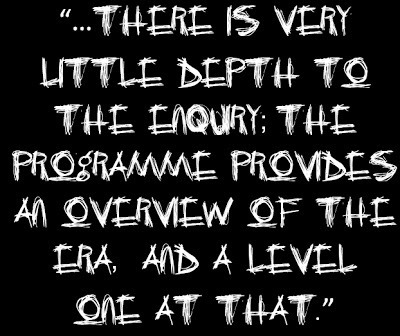 This collection was charged with the unenviable job of serving as a digest of this unforgettable epoch of sports entertainment – something that I was pleasantly surprised to see it do admirably, if not definitively (they’d have needed half a dozen discs at least for that). There are almost as many promos and skits to be enjoyed here as there are full-length matches, which certainly fits with my recollection of the programming, and the matches that have been chosen have mainly been lifted from RAW (and in a few cases later on, SmackDown!), which, whilst not really a fair representation of the quality of the matches, will please most of those who buy the blu-ray as the pay-per-view matches have all seen commercial release at least once (and are still readily available in the UK without any post-lawsuit censorship, at least for now, as part of Silver Vision’s Tagged Classics range).
This collection was charged with the unenviable job of serving as a digest of this unforgettable epoch of sports entertainment – something that I was pleasantly surprised to see it do admirably, if not definitively (they’d have needed half a dozen discs at least for that). There are almost as many promos and skits to be enjoyed here as there are full-length matches, which certainly fits with my recollection of the programming, and the matches that have been chosen have mainly been lifted from RAW (and in a few cases later on, SmackDown!), which, whilst not really a fair representation of the quality of the matches, will please most of those who buy the blu-ray as the pay-per-view matches have all seen commercial release at least once (and are still readily available in the UK without any post-lawsuit censorship, at least for now, as part of Silver Vision’s Tagged Classics range). Amongst dead-cert segments such as Mike Tyson joining D-Generation X; the Corporation’s pre-WrestleMania XV beer bath; the arrival of Y2J; and, of course, the ill-fated Stephanie McMahon / Test wedding, I was particularly pleased to find little gems such as Steve Austin’s fourth WWF Championship victory (the night of King of the Ring ’99 on RAW); Triple H’s now-infamous “I am
The
Game!” interview with Jim Ross (from an early episode of Sunday Night Heat); and some really powerful Ministry of Darkness stuff, including the Undertaker’s late ’98 mock-crucifixion of Austin and his ‘unholy union’ with Stephanie (the night after Backlash ’99 on RAW). Even more interesting to me though was the stuff that I’d never seen, or had only caught the punchline of in a clip somewhere long after the event – material from RAW through ’97 and ’98, and segments from early episodes of SmackDown! that either weren’t broadcast in the UK at all, or were shown heavily-censored on an early morning slot on Sky 1.
Amongst dead-cert segments such as Mike Tyson joining D-Generation X; the Corporation’s pre-WrestleMania XV beer bath; the arrival of Y2J; and, of course, the ill-fated Stephanie McMahon / Test wedding, I was particularly pleased to find little gems such as Steve Austin’s fourth WWF Championship victory (the night of King of the Ring ’99 on RAW); Triple H’s now-infamous “I am
The
Game!” interview with Jim Ross (from an early episode of Sunday Night Heat); and some really powerful Ministry of Darkness stuff, including the Undertaker’s late ’98 mock-crucifixion of Austin and his ‘unholy union’ with Stephanie (the night after Backlash ’99 on RAW). Even more interesting to me though was the stuff that I’d never seen, or had only caught the punchline of in a clip somewhere long after the event – material from RAW through ’97 and ’98, and segments from early episodes of SmackDown! that either weren’t broadcast in the UK at all, or were shown heavily-censored on an early morning slot on Sky 1.
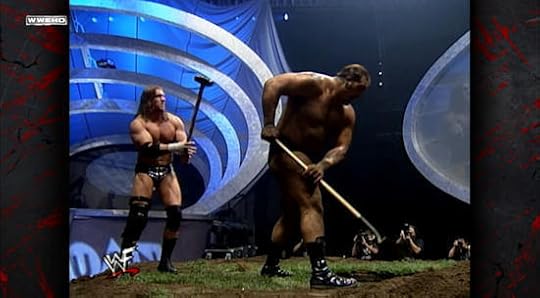 For instance, there’s a brilliant teaser trailer (entitled “Soldier of Love”) for Val Venis’s impending arrival that sees him appear naked (save for a combat helmet) in a bush with none other than Jenna Jameson, one of the most popular pornstars in the world at that time, and a Buried Alive Match from SmackDown! that, for me, encapsulates the era entirely. It may be billed as the Rock and Mankind defending their World Tag Team Championships against the Undertaker and the Big Show in a Buried Alive Match, but inevitably Triple H sticks his sledgehammer in, and so Austin commandeers an ambulance... Ditto the full-blown Survivor Series-style elimination match that sees Austin, the Rock, Kane and Shane McMahon take on all four members of the recently-reformed D-Generation X. And happily none of the material is spoiled by censorship – save for on the cover art, where the ‘F’ in the WWF scratch logo is mischievously obscured by a blob of DX-green paint, none of the material has had the ‘F’ pixelated and the soundtrack is free from those incongruous silences that used to arise on post-2002 releases wherever the soundbite “WWF” had had to be excised.
For instance, there’s a brilliant teaser trailer (entitled “Soldier of Love”) for Val Venis’s impending arrival that sees him appear naked (save for a combat helmet) in a bush with none other than Jenna Jameson, one of the most popular pornstars in the world at that time, and a Buried Alive Match from SmackDown! that, for me, encapsulates the era entirely. It may be billed as the Rock and Mankind defending their World Tag Team Championships against the Undertaker and the Big Show in a Buried Alive Match, but inevitably Triple H sticks his sledgehammer in, and so Austin commandeers an ambulance... Ditto the full-blown Survivor Series-style elimination match that sees Austin, the Rock, Kane and Shane McMahon take on all four members of the recently-reformed D-Generation X. And happily none of the material is spoiled by censorship – save for on the cover art, where the ‘F’ in the WWF scratch logo is mischievously obscured by a blob of DX-green paint, none of the material has had the ‘F’ pixelated and the soundtrack is free from those incongruous silences that used to arise on post-2002 releases wherever the soundbite “WWF” had had to be excised.
 The documentary that adorns the first disc is almost as impressive, though admittedly I was a little disappointed with its 57-minute running time – after all, there was easily enough fodder here for WWE to have produced a three-hour programme in The Rise and Fall of ECW mould, recounting all the most significant angles and off-screen developments. The practical upshot of this is that there is very little depth to the enquiry; the programme provides an overview of the era, and a level one at that. The exploits of Shawn Michaels; “Stone Cold” Steve Austin; the Rock; Mankind; Triple H; and the Undertaker are not examined in any more detail than those of the Oddities; “Head Cheese”; or Kaientai. However, the feature still complements the material presented well, affording it context and allowing it to be appraised from a modern perspective. Those looking for something more exhaustive will have to invest in the various Superstar-specific titles from this era to boot, such as The Bottom Line on the Most Popular Superstar of All Time and The Epic Story of Dwayne “the Rock” Johnson.
The documentary that adorns the first disc is almost as impressive, though admittedly I was a little disappointed with its 57-minute running time – after all, there was easily enough fodder here for WWE to have produced a three-hour programme in The Rise and Fall of ECW mould, recounting all the most significant angles and off-screen developments. The practical upshot of this is that there is very little depth to the enquiry; the programme provides an overview of the era, and a level one at that. The exploits of Shawn Michaels; “Stone Cold” Steve Austin; the Rock; Mankind; Triple H; and the Undertaker are not examined in any more detail than those of the Oddities; “Head Cheese”; or Kaientai. However, the feature still complements the material presented well, affording it context and allowing it to be appraised from a modern perspective. Those looking for something more exhaustive will have to invest in the various Superstar-specific titles from this era to boot, such as The Bottom Line on the Most Popular Superstar of All Time and The Epic Story of Dwayne “the Rock” Johnson.
Ultimately there is a reason that this anthology comes clad in a Sergeant Pepper-style sleeve. Like the Beatles’ seminal work, the Attitude Era remains pro wrestling’s magnum opus, and like the fab 1967 LP, it truly broke the mould. Its long-running angles broke new ground in storytelling; its contentious tone and subject matter offended as many as it impressed despite the programmes’ clear ‘PG-13’ warnings. From the generally-accepted birth of Attitude in late 1997 all the way up to WWF owner Vince McMahon’s purchase of rival WCW in 2001, and I dare say a little beyond (in my view there was still plenty of Attitude left in the product even as late as the company “getting the ‘F’ out” and splitting the engorged roster in 2002), these Superstars set a new standard. Would I let my daughter watch this stuff? Hell no! But that it is, after all, its appeal.
Published on April 01, 2013 07:11
March 31, 2013
Book Review | Star Trek: Voyager - The Eternal Tide by Kirsten Beyer
 The Eternal Tide is the most divisive Star Trek: Voyager novel published to date; it’s also probably the finest. Where you stand on its merits will probably depend more on your attitude towards the fate of the television series’ focal character and your views on death within the Star Trek canon generally than it will the intrinsic quality of the work, but for the purposes of an introductory soundbite, suffice it to say that Kirsten Beyer’s hottest novel is the literary equivalent of a season finale, drawing together two threads that have hung loose ever since Kathryn Janeway met her end amidst the pages of Peter David’s almighty Before Dishonor. Love it or loathe it, this book is an event.
The Eternal Tide is the most divisive Star Trek: Voyager novel published to date; it’s also probably the finest. Where you stand on its merits will probably depend more on your attitude towards the fate of the television series’ focal character and your views on death within the Star Trek canon generally than it will the intrinsic quality of the work, but for the purposes of an introductory soundbite, suffice it to say that Kirsten Beyer’s hottest novel is the literary equivalent of a season finale, drawing together two threads that have hung loose ever since Kathryn Janeway met her end amidst the pages of Peter David’s almighty Before Dishonor. Love it or loathe it, this book is an event.Conceptually, The Eternal Tide is larger than even the most of inventive of us could have imagined, toying with ideas of predetermination and providence as the most creative and most destructive forces in creation collide ahead of schedule, forcing the multiverse to turn to two former Voyager captains to bring them back into balance, and in doing so seal their respective fates. It’s dazzlingly ambitious and scintillatingly written, showcasing the author’s remarkable talent for fusing hard science with soap opera as her plot turns as much on budding romantic endeavours and the wonders and terrors of parenthood as it does fixed points in time and the end of all things.
As the Voyager fleet continues to explore former Borg space, its fleet commander, Captain Afsarah Eden, continues to investigate her mysterious and unique lineage, leading her to a discovery that forces Starfleet to take stock of its understanding of the universe, and face up to a threat greater than anything that it’s ever faced before. And that’s not stock blurb hyperbole – it literally is the greatest threat ever faced by the Federation, the Alpha Quadrant, or the Milky Way for that matter; even the Q Continuum is running blind and scared. “Meanwhile”, Q – and by Q, I don’t mean the Q made famous by actor John de Lancie; I mean his son, as played by de Lancie’s son – has stumbled upon only a void where his future should be. Terrified to his omnipotent core, he probes the multiverse for evidence of what could have erased his future, and discovers that the multiverse seems to want Vice-Admiral Janeway dead. When his “Aunt Kathy” died at the hands of the Borg in Before Dishonor, she died in every single possible timeline, and that couldn’t possibly be. Drawing a link between his godmother’s unequivocal death across creation and his own omnipotent oblivion, Q posits that that the multiverse is trying to put something right – something that went wrong when the future Admiral Janeway travelled back in time to alter history to bring Voyager home early in the television series’ finale, Endgame. To find out what that something might be, and with a view to correcting it, he does what no Q should ever do; what is given away not only by the book’s mission statement of a cover, but its earliest passages too – he conspires to bring Janeway back from the dead.
Perhaps anticipating a backlash, Beyer offered her would-be critics justification for her actions in an introductory note, opining that this story “required telling”. I was unconvinced for one inescapable reason: whenever a long-running series brings a character back from the dead, particularly one as central to it as Janeway was to Voyager, it not only debases the significance of that death in the first instance, but takes weight away from any subsequent deaths as readers know that the apparently-deceased character could feasibly reappear at any point. Of course, Janeway isn’t the first big Star Trek character to receive such treatment in print – Enterprise’s winker, Trip, and Deep Space 9’s Prophet-walker, Sisko, are probably the most prominent examples – but she is the only one that I can think of who met her doom in this medium, and did so quite decisively. There were no clear celestial cop-outs or hang-on-a-minute winks waiting in the wings to undo what Peter David did, and for me that made Janeway’s “cop-out comeback” even harder to swallow.
The novel also draws upon countless Voyager stories beyond its immediate predecessors, utilising Riley Frazier and the Borg Co-operative encountered in Unity; the eponymous Omega particle of The Omega Directive; and, most importantly, the Q Continuum. Were The Eternal Tide a Doctor Who novel, such a confluence would be summarily dismissed by many potential readers as “fanwank” – a term generally reserved for the most indulgent and self-referential of tales, written by the fans and for the fans. I think that anyone who has ever read any of Beyer’s Voyager works would attest that her love for the characters and the subject matter rivals that of any regular fan, and certainly her knowledge of previous novels and episodes must border on encyclopaedic, but her preceding novels all managed to strike an acceptable – no, a pleasing – balance between forging for the future and looking back over the shoulder. The Eternal Tide shows no such restraint, and it lives and dies as such.
By the time that I’d purchased it, I’d resigned myself to the fact that Janeway was coming back; I’d even convinced myself that the evident indestructibility of Spock and his Trek heredity weren’t so much fan-appeasing slams down on the reset button as they were endorsements of Gene Roddenberry’s unblemishable vision of the future. Then I remembered that Simon & Schuster had used the Borg to kill off sixty-three billion Federation citizens and bring Starfleet to its knees. Then I wondered how Janeway must feel about that, as it was her destruction of the Borg’s transwarp hub that set in motion the sequence of events that brought the Borg back to the Alpha Quadrant, hell-bent on vengeance. Then I started to get it.
Whilst ostensibly The Eternal Tide is an evasion of the ultimate consequence, it’s actually a discourse on consequences; a study of cause and effect on both a personal and a multiversal scale. Beyer’s story takes something as colossal as a sixty-three billion death toll, and looks at what effect it would have on an individual conscience. She studies loss and grief, and then turns to what might happen were that loss to be undone more than a year after the event. She even breaks the fourth wall as meta-fictional debates rage over a single death and mooted resurrection. Most movingly of all though, she looks at the bonds between parents and their children in its many forms – Tom, B’Elanna and Miral; Riley’s people and their offspring; Jobin, Teller and Afsarah; Janeway and her erstwhile Voyager crew; all the way up to the transcendent Q, Q and Q – and how it defines who we are, what we do, and what we’re capable of under duress. There is a moment in this story when a man is prepared to let the multiverse end aeons earlier than it otherwise would have, all so that he may avert his child having to sacrifice her life. It’s powerful, enchanting material hidden beneath a veil of fanwank – the ultimate guilty pleasure for any open-minded and forgiving Trekker.
Published on March 31, 2013 00:16
March 30, 2013
Happy Birthday to Who

With Doctor Who now at home in the mainstream, you’d have to have been living under a rock not to know that it celebrates its fiftieth anniversary on 23rd November, cementing its legacy as the world’s longest-running science fiction series (whatever Stargate SG•1 fans say).
Despite The History of the Doctor having closed its doors to new stories, I will continue to update it over the anniversary year as I replace the last few of my classic series reviews with reviews of their 2|entertain DVDs (including Paradise Towers, The Legacy Collection, The Reign of Terror, and The Ark in Space and The Aztecs special editions, which I’ve fallen behind with).
I’m also planning to pinch (a slightly-altered version of) former History boy Daniel Tessier’s fantastic idea and, between now and November, review a story from each Doctor’s era that I’ve not reviewed before for this blog. To that end, I’ve already capitalised on Big Finish’s Chocolate Weekend sale, purchasing Voyage to Venus / Voyage to the New World (Colin Baker); UNIT: Dominion (Sylvester McCoy); and Dark Eyes (Paul McGann). Watch this space for reviews of those over the coming weeks.
And of course, the television series returns to our screens tonight with Steven Moffat’s promising episode The Bells of Saint John, which will see the Doctor and his new companion investigating a threat lurking in London’s Wi-Fi networks. I’m making no promises about ongoing new series reviews, as my little girl seems intent on waking me up at 5am daily at the moment, but I suspect that it won’t be too long before I have to succumb to gravity’s pull. For now, I’ll just wish a very happy birthday to Who.
Doctor Who returns to BBC One and BBC One HD tonight at 6.15pm. Check out its prequel here.
Published on March 30, 2013 04:57
E.G. Wolverson's Blog
- E.G. Wolverson's profile
- 52 followers
E.G. Wolverson isn't a Goodreads Author
(yet),
but they
do have a blog,
so here are some recent posts imported from
their feed.









